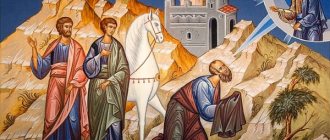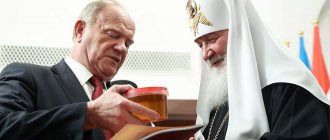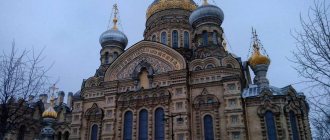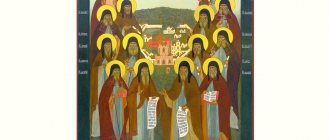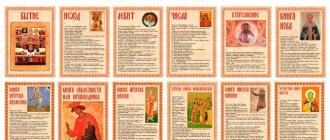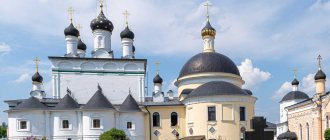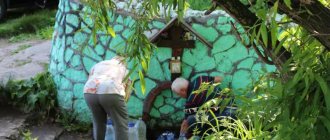There is a new governor in Optina Pustyn. We tell you what we know about him
The decision to change the abbot in one of the most famous Orthodox monasteries in the world was made on December 29 in Moscow at a meeting of the Holy Synod. The meeting was chaired by His Holiness Patriarch Kirill of Moscow and All Rus'.
Judging by the synodal journals, before deciding to change the governor, the Synod first heard “judgments” on the state of affairs in the Vvedensky stauropegic monastery of Optina Pustyn. On paper it looks like this:
“MAGAZINE No. 105
HAD A JUDGMENT about the state of affairs in the Vvedensky stauropegial monastery of Optina Pustyn.
DECIDED:
1. To relieve His Grace Bishop Leonid of Mozhaisk from his post as abbot of the Vvedensky stauropegial monastery of Optina Pustyn.
2. The vicar of the Vvedensky stauropegial monastery of Optina Pustyn and the vicar of the Patriarch of Moscow and All Rus' should be His Grace Bishop Joseph of Tarusa with the title “Mozhaisk”.
3. His Eminence Leonid to be vicar of the Kaluga diocese with the title “Tarussky.”
Let us recall that Bishop Leonid was appointed vicar of Optina in July 2018, before which he ruled the Urzhum diocese.
In the cradle of eldership, Father Leonid was his own man; it was here in 2003 that he was tonsured a monk by the abbot of Optina Hermitage, Archimandrite Venedikt (Penkov).
The brethren and parishioners of the monastery remembered Father Leonid as a man who paid a lot of attention to preserving the history of the monastery.
“There were some materials that I found that were not known, I will say so. Only later did the governor, the late Father Benedict, put me on an obedience not related to publishing. I ended up working on a subsidiary farm because I had the necessary education - I spent probably about ten years there. Passed almost all obediences: stables, poultry house, gardens, even worked as a machine operator for one winter. He was a dean and the manager of a subsidiary farm for some time,” said Father Leonid shortly after his appointment to the position of governor.
Having taken the helm of the famous monastery, Bishop Leonid continued to study history and education. Before the pandemic, lectures that were held in the monastery at the suggestion of the governor were popular.
At the same time, Father Leonid became famous for closing the monastery’s monastery monastery from visitors - the one that forever entered the history of both the Russian Church and Russian culture.
His role as governor has yet to be assessed by his contemporaries, but for now a new page is opening in the history of Optina.
The current governor of Optina Monastery is also no stranger to the monastery and Kozelsk. As vicar of Metropolitan Clement of Kaluga and Borovsk, Bishop Joseph often visited the Kozelsky region, he was on good terms with the brethren of the surrounding monasteries and personally with Bishop Nikita of Kozelsky and Lyudinovsky.
Local clergy call Bishop Joseph an example of meekness and virtue.
What else is known about the new governor of Optina?
He is 44 years old, has two higher educations - Kaluga Seminary and Moscow Theological Academy. There are two more courses at the Polytechnic College in Altai, where Oleg Korolev (the worldly name of the bishop) was born. Oleg never received a secular specialty; in 1994 he entered the Pafnutiev Borovsky Monastery as a novice. It is interesting that as a monk he was tonsured with the name Joseph in honor of the Venerable Joseph of Volotsk, this happened in 2002, but he was tonsured into the monk’s mantle in honor of the Venerable Joseph of Optina.
The current governor, while in Borovsk and then in Tarusa, was much involved in education, culture, social service and even the media.
Share with your friends:
Russian Orthodox Church
Pilgrimage obedience is an integral part of monastic life in most famous monasteries of the Russian Orthodox Church. Optina Pustyn is no exception. Both in past centuries and now, spiritual life for many people begins with a trip to the monastery. It seems that even today among those who come to monasteries as pilgrims, there are also future monks. What does pilgrimage obedience to Optina include? What do the monastic guides tell the guests who come to the monastery? Are there elders in modern monasteries and from whom can one get spiritual advice? Hegumen Lavrenty (Balaev), responsible for the pilgrimage service, answered these and other questions for the Monastic Bulletin portal.
— Father Lavrentiy, before the start of the coronavirus pandemic, how many pilgrims visited the monastery and how much has their number decreased now?
— We constantly feel increased interest in our monastery. Comparing the indicators for the summer months of 2022 and 2022, I can say that the number of pilgrims not only did not decrease, but we even observed a slight increase. True, there are fewer tour groups. Pilgrims now come to our monastery mainly privately. But the work of the excursion service has not decreased, which we are very happy about. People who come to the monastery for the first time want to learn more about Optina Hermitage, its elders, shrines, history, book excursions, and our task is to help them with this.
— From what regions do pilgrims now come to Optina Pustyn?
— Previously, people came from all over the world. Now, mainly from Moscow and the Moscow region, since not all regions of our country have a calm epidemiological situation. Before the pandemic, groups came from all over Russia, from Serbia, Germany, France and even Australia, and of course, from Belarus and Ukraine. Moreover, pilgrims came from Ukraine even in the most difficult times. Ukrainians are generally pious people. They are very sensitive to divine services, visiting temples and prayer... And recently, students from Indonesia came to us. From them I learned, for example, that in our exarchate there are about 60 Orthodox churches there.
—Are there enough hotels and refectories in the monastery to accommodate a large flow of pilgrims?
“Hand on my heart, I can’t say that there are enough resources in the monastery itself.” Nearby hotels help us with accommodation and meals. In our monastery, of course, there are places to stay and refectories, but in order to accommodate the entire flow of pilgrims, there must be much more housing and public catering places. However, the monastery does not set itself the goal of satisfying any needs of the people who come to us. The main thing is that Optina is open for communication. Pilgrims come in large numbers to confession. For many, their acquaintance with the monastery occurs after a conversation with the priests, who are also carriers of the Optina spirit. The most important thing is that people attend divine services, where the Lord Himself speaks with all of us.
To communicate with pilgrims you need love and a desire to talk with people on spiritual topics
— Our life can be divided into periods “before the pandemic” and “after.” Tell me, before the pandemic, didn’t the brethren complain about the discomfort that pilgrims cause to the inhabitants of the monastery, distracting the monks from their prayer work?
— In Optina Hermitage, our life is organized in such a way that pilgrims do not disturb the brethren. The fraternal territory is separated from those places that are accessible to the laity. The brothers who carry out obediences related to receiving guests are usually on duty in the church or working behind the candle box. During divine services, the monastery’s inhabitants also pray in “their own space,” separately from the laity. I didn’t notice any painful tension or grumbling from myself or my brethren about this. Moreover, the monks are interested in working in the excursion service. They themselves want to better learn the history of the monastery and introduce it to other people. Those who do not want to do this are not forced by the Hierarchy to such obedience. With a sour expression on your face you can probably do almost everything except communicate with people. To conduct excursions, you need love and a desire to talk with people on spiritual topics. After all, this is not only working with words, but also with souls. In the eyes of people, the guide sees the attitude of the pilgrims to what he is talking about and to the way he himself lives. Some of our guides even noticed that fatigue after communicating with pilgrims seems insignificant compared to the joy that fills the soul.
— For many people, spiritual life began with a pilgrimage to Optina Pustyn. In this regard, I would like to ask how you select tour guides?
— Here again, the starting point is love for God and people. I was first asked to give a tour when I was a novice in the monastery refectory. And even then I realized that the most important secret is the blessing of the governor. All our guides are absolutely sure of this, because the Lord Himself helps in holy obedience. I always tell the person conducting the excursion that if suddenly it becomes too difficult for him to talk, then our pilgrims will definitely come to the rescue - they will ask an interesting question, they themselves will suggest some topic... After all, there is no need to convey a dry message to the listener information, historical information and dates. Pilgrims must see faith and life according to faith in the eyes of the monastery resident. Only then can they want to live a spiritual life when they see a worthy example to follow. We proceed from this principle. And almost all our brothers strive for purity of life, and it is impossible not to notice this desire.
— What questions do pilgrims most often ask you during excursions?
— Now the range of issues has changed a lot. Perhaps this is due to the fact that I myself have changed. I am a priest, with a cross, in a cassock, and the most frequently asked questions are somehow related to how a person can build his spiritual life. In other words, how can we make the Lord God enter a person’s life? Usually, after such questions, our conversation turns into a conversation of spiritual and moral content. I always try to support my answers with examples from the life of the Optina elders.
In one of the books published in the 1990s, I read the following parable. The pagan hired a believer on the condition that he would not say a word to him about religion. A year later, the employer himself came to this employee with tears in his eyes, begging him to help him become a Christian. From this example, one can be convinced that the task of Orthodox people is to testify to the whole world with their own lives that God is with us, so that people want to live like us. The Apostle Paul wrote in his First Epistle to the Corinthians: I have made all things unto all, that I might save some (1 Cor. 9:22).
And our guides also know that an individual approach is very important in conversations with pilgrims, since different people have different needs. In confession, people are often surprised when I ask a question about who the person is by profession. But you have to place completely different accents, depending on who came to you: an engineer, an astronaut, a military man or a housewife. Work is a reflection of a person's life.
— How do the brethren of the monastery react when provocative-looking pilgrims come to the monastery - in revealing clothes, with tattoos on their bodies or overly extravagant hairstyles?
“In such situations, of course, one must show patience, forbearance and love. It is impossible to raise a person without love. In my opinion, if people came to the monastery, it means that they have a desire to hear the truth. If they enter the monastery in inappropriate clothing and no one tells them anything, they may misinterpret it. In my memory, there were many cases when a person came to confession in an inappropriate form, but after talking with the priest he realized that this was wrong. But, again, comments must be made patiently and in a gentle manner.
As for open clothing, previously we had monks on duty, and there was no need to offer pilgrims any additional clothing - people themselves understood in what form they should come to the monastery. Now at the holy gates a person wearing open clothes is given special capes, which we try to keep in proper condition.
— What do the guides tell the guests of Optina about?
— First of all, we try to introduce tourists to the history of the monastery: we talk about the origins and development of Optina. After all, at first it was a run-of-the-mill monastery, but after his visit to Optina, Metropolitan Platon (Levshin) (†November 11 (23), 1812) invited monks here, and it was from that moment that the monastery began to flourish. The monastery experienced its greatest growth during the periods of abbotship of Hegumen Abraham († January 14 (27), 1817) and the Monk Moses of Optina († June 16 (29), 1862).
The central part of the story is the biography of the venerable Optina elders and their teachings. So that people feel the spirit of each of them, we read excerpts from the letters of the prpp. Ambrose, Macarius, Lev Optinsky, dedicated to various problems. Next we talk about the period of closure of Optina Pustyn after the October Revolution of 1917. We carefully studied the issue related to the future life of the inhabitants of the monastery, inquiring in detail about where and how they ended their days. Then we move on to the topic of the revival of the monastery and the modern life of the monastery. Almost always our story is interspersed with questions of a spiritual and moral nature. There are almost no excursions that contain only dry information. Pilgrims always ask questions, which turn the informative story of the monk-guide into a spiritual conversation.
A person’s spiritual life often begins with a pilgrimage to a monastery
— Do you think it is necessary to somehow prepare for a pilgrimage trip to the monastery? What would you advise a person who is planning to visit Optina to read or do in preparation for the pilgrimage?
— To this question, when asked in a letter that comes to our e-mail ( [email protected] ), I answer this way: the main thing is not to forget to enlist the blessing of your confessor. Asking for blessings for any undertaking is very important. After all, you receive God's blessing, which will accompany, protect and strengthen you. Visiting holy places requires special prayer preparation. When going on a pilgrimage to Optina Pustyn, it is advisable to read the lives of the Optina elders and pray to them. The Lord will arrange the rest. Of course, you need to understand that difficulties may arise during the trip. In the last century, people had to make great efforts to make pilgrimages. Nowadays, the conditions of any journey have become much more comfortable, but the Lord always gives a person trials. Be it difficulties in communication or in relationships. People often say that during the pilgrimage, although everything was going well, some problems unexpectedly arose. We must understand that a test of faith is an integral part of visiting a shrine. The Christian understands the real reason for these difficulties.
— From Moscow you can come to Optina Pustyn with a pilgrim bus, which departs every Saturday from the monastery courtyard. Trips are also organized by many pilgrimage services. But there are people who prefer to travel independently. Which method would you call the most correct for the Optina pilgrim?
— We accept everyone who comes, regardless of how people get to us. We conduct both group and individual excursions with equal cordiality and conscientiousness. The easiest way to get to the monastery is to come with a group from your temple. In general, in spiritual life, in addition to prayer, it is very important to beg God for a temple or monastery, the parish of which would become one’s own for a believer. Being a regular parishioner of a particular church is very important for a Christian. After all, it will not be possible to go on a pilgrimage every week, and at the parish the priest will definitely give the person some kind of assignment. For example, he will be involved in joint preparation of holidays, cleaning the temple, and trips. A person begins to participate in the affairs of the parish, and gradually becomes a full member of the Church. Personally, at one time I really liked this - after all, this is spiritual development.
On the Optina website, in the “Pilgrimage” section, all possible ways of pilgrimage trips are described in detail: by public transport - from which station, what schedule does the bus or train run on, what route should you take by personal transport. Hotel phone numbers for pre-booking rooms and the pilgrim service phone number for booking excursions are provided. Everyone is welcome.
— Are there among the brethren those who began their monastic journey with a pilgrimage to Optina Pustyn?
“I can’t say that there are many such monks, but they exist.” Many of the Optina brethren became acquainted with spiritual life by visiting one or another monastery. This is exactly how the desire to be a church person sometimes arises. People begin to read the holy fathers and come to the monastery more often. Then the periods of stay in the monastery increase. So there are certainly benefits from pilgrimage. This is one of the mandatory areas of the Church’s activity that needs to be developed.
I always try to advise people to visit holy places, even if they are going on vacation to a resort. I remember once I asked one person who was traveling to Greece to bring me something as a souvenir from the Cathedral of Demetrius of Thessaloniki in Thessaloniki, since this person, as I thought, should have been somewhere nearby. When he returned, he said that his journey there from the place where he rested was more than 300 kilometers. But, having promised to bring me a souvenir, my friend considered it important to fulfill the promise. He chose a cloudy day for the pilgrimage; he was very tired on the road, but he was very impressed and did not regret the trip.
So, if a person visits a holy place while on vacation, this will add pleasant memories of the time spent.
We attach great importance to the pilgrimage movement. After all, sometimes a person enters a temple only to light a candle or write notes. But if we offer him our booklet about the pilgrimage to Optina, then there is hope that next time his acquaintance with the monastery, and therefore with the Church, will be deeper. I repeat once again: if a person came to us, this means that he has already shown interest in church life, and it would be wrong not to answer him.
Interviewed by Ekaterina Orlova
Synodal Department for Monasteries and Monasticism/ Patriarchia.ru
OPTINA PUSTIN
OPTINA PUSTIN, an Orthodox stauropegial (since 1987) male monastery in honor of the Entry into the Temple of the Blessed Virgin Mary, located approximately 3 km from the city of Kozelsk (Kaluga region), near the river. Zhizdra.
Optina Pustyn. General form. Photo by A. I. Nagaev
The name, according to legend, goes back to the legendary repentant robber Opta, who allegedly founded the O. p. It is more likely that the name is connected with the period of joint (“wholesale”) residence in the monastery of monks and nuns. Perhaps the foundation of O. p. dates back to the 15th century. It was first mentioned in the scribe books of Kozelsky. for 1629–31 (the text contains an indication of the existence of O. p. in the late 16th century). During the Time of Troubles, the O.P. was most likely ruined, but was soon restored. The monastery's investors were Tsarevna Sofya Alekseevna, Tsar Ivan V Alekseevich, his wife Tsarina Praskovya Feodorovna, Tsar (from 1721 Emperor) Peter I, and others. In 1724, the O.P. was abolished and assigned to the Belyov Spaso-Preobrazhensky Monastery, but already in 1726, at the request of benefactors, it was restored. In 1764 it was designated as a provincial monastery; the brotherhood consisted of several monks. The gradual revival of O. p. began with the end. 18th century, which was facilitated by the activities of Metropolitan. Moscow Platon (Levshin). In 1821, under the patronage of bishop. Kaluga (later Metropolitan of Kyiv) Philaret (Amphiteatrov) near the O. p. for a solitary monastic life, the St. John the Baptist monastery was founded, in which those invited to the monastery of Bishop began to asceticize. Filaret the ascetics brothers Moses (Putilov) and Anthony (Putilov) and several others. monks In 1824, a strict communal charter was adopted in the community center based on the charter of the Konevsky Nativity of the Mother of God Monastery.
Icon "The Council of the Reverend Elders of Optina". Late 20th century Workshop of Optina Pustyn. Church in honor of the Vladimir Icon of the Mother of God of Optina Hermitage.
During the period of the abbotship of Schema-Archimandrites Moses (Putilov) (1826–62, actually from 1825) and Isaac (Antimonov) (1862–94), the O.P. gained wide popularity thanks to its eldership. The tradition of Optina eldership goes back to the disciples of St. Paisiy Velichkovsky and originates from the settlement in 1829 of Hieroschemamonk Lev (Nagolkin) in O. The elders lived in the monastery of St. John the Baptist. Here it was possible to ensure the continuity and continuity of the eldership: after the death of the elder, the elder brethren chose his successor, sometimes serving several times. elders at the same time. The most revered Optina elders were hieroschemamonks Lev (Nagolkin), Macarius (Ivanov), Ambrose (Grenkov; see Ambrose of Optina), Hilarion (Ponomarev), Anatoly (Zertsalov), Joseph (Litovkin), schema-archimandrite Varsonofy (Plikhankov), hieroschemamonks Anatoly ( Potapov), Nektary (Tikhonov) and Hieromonk Nikon (Belyaev). The elders received and cared for not only the brethren, but also all willing pilgrims, and corresponded with them.
Among the many visitors to the elders - bishops [Metro. Ioannikiy (Rudnev), bishop. Nikon (Rozhdestvensky), St. Macarius (Nevsky), plural. Kaluga bishops, etc.], members of the imp. families (Grand Prince Konstantin Konstantinovich with children, Grand Prince Primts. Elizaveta Fedorovna), scientists, philosophers, writers, poets (N.V. Gogol, brothers I.V. Kireevsky and P.V. Kireevsky, K. S. Aksakov and I. S. Aksakov, S. P. Shevyrev, M. A. Maksimovich, A. N. Muravyov, F. M. Dostoevsky, K. N. Leontyev, V. S. Solovyov, L. N. Tolstoy, S. A. Nilus, S. N. Durylin, etc.).
Since the 1840s On the initiative of Elder Macarius (Ivanov), the most educated monks of the O. p., including Leonid (Kavelin) and Juvenaly (Polovtsev), carried out educational activities. Thanks to the organizational efforts of Father Macarius (Ivanov), I.V. Kireevsky and others, the patronage of a number of hierarchs, primarily Metropolitan. Moscow St. Philaret (Drozdova), O. p. received the opportunity to conduct publishing activities: translations of the works of the Venerable Barsanuphius the Great and John the Prophet, Abba Dorotheos of Gaza, the Venerable Mark the Ascetic, John Climacus, Simeon the New Theologian, Theodore the Studite, Maximus the Confessor, Isaac the Syrian, John of Damascus, works of St. Nil Sorsky and others, biographies and correspondence of the Optina elders. Valuable manuscripts were kept in the libraries of the O. p. and the monastery, the oldest of which is Slav. manuscript “Words of the Fasting” by St. Isaac the Syrian, copied in 1389 in the Great Lavra on Mount Athos. A chronicle was kept at the St. John the Baptist Skete, covering the time from 1820 to 1918 (with the exception of 1861–1864 and 1883–99), which recorded the composition and movements of the brethren, tonsures, ordination, the death of monastics, the arrival of famous people, large donations, monastic construction, the publication of books prepared by monks, as well as particularly important events in the church and political sphere. life of Russia, wonderful events, etc.
"View of the monastery of St. John the Baptist." Lithography. 1881.
At 19 – beginning. 20th centuries the number of inhabitants of the O. p. grew rapidly; by 1915, 355 monastics lived there. Mn. monks of the O. p. were appointed to high positions in other monasteries and spiritual missions; Ignatius (Brianchaninov), Yuvenaly (Polovtsev), Trifon (Turkestanov), Mikhei (Alekseev) became bishops. From 2nd quarter 19th century The financial position of the O.P. was strengthened, large-scale construction was carried out, and several were opened. factories and workshops, a water supply system was installed, and the Optina breed of cows was bred. The brethren were actively involved in charity work: a school was opened at the O.P., an orphanage, an orphanage, and an almshouse were established. During the Russian tour. wars of 1877–78, Russian-Japanese. During the war of 1904–05 and the 1st World War, the monastery hospital admitted the wounded, the monastery allocated places for refugees, and made donations for the needs of the army.
In 1918, the monastic community was officially closed; the monastic community continued to exist as an agricultural community. artel With the liquidation of the artel in 1923, the remaining monastics were evicted, many of them were subsequently sent into exile or shot. In 1919–28, the Optina Pustyn Museum operated on the territory of the O. p. and the monastery. After the closure of the museum, the Optina archive ended up in the State. USSR Library named after. V.I. Lenin (now makes up funds 213 and 214 of the Department of Manuscripts of the Russian State Library). Over the years, on the territory of the O.P. there was a rest house (since 1931), an NKVD camp (1939–41), and an evacuation center. hospital (1941–43), orphanage (since 1949), professional-technical. school (since 1959). Archit. The O.P. ensemble suffered great losses. In 1974, O.P. became one of the objects protected by the state, and slow restoration of the buildings began.
O. item was returned to the Russian Orthodox Church on November 17, 1987; The monastery was restored and acquired the status of stauropegial. 1.2.1990 transferred to the monastery b. part of the monastery (the other part belonged to the literary department of the Kozelsky Museum in 1967–2005). The following were transferred as farmsteads to the O.: in 1991 in St. Petersburg, the Assumption Church. on the Lieutenant Schmidt embankment (1895–1900, architect V. A. Kosyakov), in 1997 in Moscow. Apostles Peter and Paul in Yasenevo (1751, the refectory and bell tower were added in the 1860s). On the Easter night of April 18, 1993, the murder of Hieromonk Vasily (Roslyakov) and the monks Trofim (Tatarnikov) and Ferapont (Pushkarev) took place in O.P., which caused a large public outcry. resonance.
Elder Ambrose of Optina was canonized by the local council of the Russian Orthodox Church in 1988. In 1996, the canonization of other elders as locally revered saints took place, as well as Schema-Archimandrite Moses (Putilov), Schema-Abbot Anthony (Putilov), Schema-Archimandrite Isaac (Antimonov) and Archimandrite. Isaac (Bobrakov) as part of the Council of Reverend Fathers and Elders, who shone in the Optina Hermitage. The Council of Bishops of the Russian Orthodox Church 2000 established their church-wide veneration.
The earliest of the surviving monuments of the O. p. is the Vvedensky Cathedral, built in the traditions of classicism (1750–71; partially destroyed during the years of Soviet power, restored and consecrated in 1988). Above its middle cross rises a cube topped with 5 chapters. In the 19th century the temple was expanded, the south was added. and sowing aisles (1837) and a porch with a west. entrance with paired columns raised on high pedestals. Modern architect The artistic ensemble took shape in general terms in the 19th century. In 1802–04, a 4-tier high bell tower was erected. OK. 64 m in the classicist style, completed with an attic tier with a clock and a high spire (the top was destroyed during the Great Patriotic War, restored in 1999). In 1805–11, to the south of the Vvedensky Cathedral, a cathedral was built in honor of the Kazan Icon of the Mother of God in the Empire style (partially destroyed during the years of Soviet power, restored and consecrated in 1996), crowned with a dome with a small dome without a light drum. In 1809–11, a hospital church was built in honor of the Vladimir Icon of the Mother of God (completely destroyed in the mid-20th century, restored by 1998). In 1858, the St. Venerable Church, located north of the Vvedensky Cathedral, was consecrated. Mary of Egypt and Righteous Anna, which appeared as a result of the reconstruction of the old refectory (1822–24) and was made in the style of classicism; An octagon with one head was erected on the cross-shaped building. With the advent of the new church, the monastery churches, together with the bell tower, formed a cross on the plan with the Vvedensky Cathedral in the center. In 1832–39, the territory of the O. p. was surrounded by a stone fence (partially destroyed during the years of Soviet power) with 7 towers and 2 entrance gates. The Holy Gates were located in the west. a tower with a tent topped with a figurine of a trumpeting angel.
A department was created in the St. John the Baptist Skete. architect an ensemble characterized by simplicity and modesty; most of the buildings were wooden. In the center of the site in 1821–22, Ch. monastery church dedicated to the Cathedral of St. John the Baptist - tree. a church in the Empire style, consisting of several log buildings: a vestibule, a refectory and a cube. a temple with a 7-sided apse; On the sides there are 4-column porticoes with pediments. In 1857, stone Holy Gates appeared in the monastery (on the 2nd tier there is a belfry). Stone church in the name of St. Leo ep. Katansky, etc. John of Rylsky was erected in 1901–02 in the Russian style. At the gate of the monastery there was a spring in the name of St. Ambrose of Milan with a well.
A number of buildings are located behind the fence of the O. p. In the new cemetery in 1864, a small single-domed cubic center was built. in the name of All Saints (completely destroyed in the 20th century, rebuilt in 2008). At the south gate, in 1874 a 2-story hospital building with a single-domed building was built. St. Hilarion the Great in Russian style. On the river Zhizdra was the source of St. Paphnutius Borovsky with a chapel and a bathhouse.
After the resumption of the monastery at the end. 20th century new churches were built: in 1997–2000 - in honor of the icon of the Mother of God “Spreader of the Loaves” on the territory of the monastery subsidiary farm, in 2005–07 - Transfiguration Church. near the Holy Gates of the monastery; in 2008 in the southeast. In part of the monastery, a chapel was erected over the graves of the monks killed in 1993.
